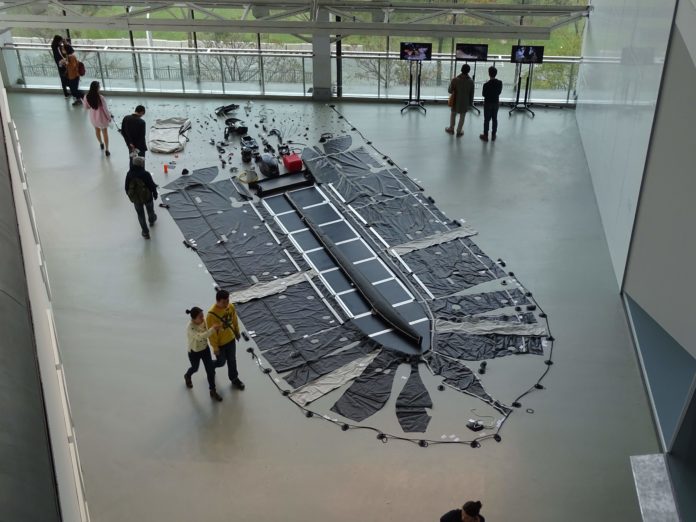by Ryan Bishop and Tania Roy
Defined as the “right of seizure: of things, time, bodies, and ultimately life itself” (1990: 136), Michel Foucault’s notion of sovereignty has acquired an exceptional degree of current salience. This is so especially in light of its possibly contrastive relation to the de-centralized force and discourse of “governmentality”[1], a neologism that Foucault developed in his later writings around the topic of bio-politics. Directly addressing the emergence of neoliberalism in advanced industrial societies in the post-War period, Foucault’s lectures on biopolitical governance suggest the breakage of contemporary modalities of organized violence from their precedents.[2] Defined, most broadly, as the “power to ‘make’ live and ‘let’ die”–and in apparent tension with the sovereign’s right to kill–the concept of biopolitics has found renewed significance for what many identify, today, as our own moment of late-liberalism. Two decades into the millennium, the current historical conjuncture does not break from the sovereign’s historical right to “things, time, bodies”, as much as enfold and accelerate that power into intensified forms of rationalized violence. Modes of sociality associated with the neoliberal organization of markets remain entangled with twentieth-century formations of sovereign power. In the bid to optimize (re)productivity on an hitherto unprecedented scale, markets are underpinned by the sovereign “right to seizure” even as they extend this traditional prerogative of the twentieth-century state into facets of both organic life, as well as the elements of life’s geo-physical environment.
In what follows, we approach the hegemonic subject of neoliberal governance through its most constitutive fantasy–what we propose as the figure, and associated idioms, of “frictionless sovereignty”. The re-imagination of sovereignty as a domain of fluid mobility has enabled the neoliberal re-organization of state and economy across the global North and South–that is to say, across disparate if interlinked histories of the territorially bound nation-state that have long been associated with the period of post-War development and decolonization, respectively. Even further, for our purposes, frictionless sovereignty is no less than the noetic precondition for imagining the limits of human life in its relation to non-life, under current conditions of extractive capitalism. In the wake of successive crises in transnational financial markets over the past decade, the search for new sources of wealth-accumulation shifts capital investment strategically to the technologies of deep-earth/-ocean extraction. To follow Elizabeth Povinelli’s mode of periodization, at the conjuncture of our “late-liberalism,” the representation of bio-ontological differences, together with the associated truth-claims of such differences, come to light as the primary object of transnational markets and their management. As a rhetorical convocation of socio-political existence under regimes of neoliberal governance, the idioms, moods and contentions of frictionless sovereignty serve, altogether, to assemble the domain of “life” as at once different from its immersive geo-physical environment and as the infinitely extensible exercise of sovereign right over the markers, materialities and distribution of such difference.
Evoked in the image of the borderless exchange of finance, goods, information, or personnel, the idiomatics of an immaterial (“frictionless”) subjectivity are underpinned, today, by a mode of capitalism for which the organization of markets are increasingly tied to the management of orders of life and non-life. As such, our proposition of frictionless sovereignty serves to historicize the “globalist” parameters of neoliberal governance by situating these in the proliferation of bio-political differences across, under and above territorially bound formations of sovereignty. More significantly, frictionless sovereignty indexes the experience of the increasingly erodible nature of these very differentiations, insofar as the unbundled movement of sovereignty renders its own border-concepts increasingly frangible.
What particular exposition of the biopolitical is offered through our current imagination of the elemental aspects of the environment–a moment marked by the urgent if inchoate knowledge of “geontopower [understood as] a set of discourse, affects and tactics used … to maintain or shape the coming relationship of the distinction between Life and Nonlife?” (Povinelli, 4).[3] What topographies of accumulation and unevenness surface in that late formation of the globalist imaginary–the specifically liquid element of the human milieu that once comprised the limit-term of the border, the partition, the humanly habitable, by overwriting these spatial socio-political orders of sovereignty with semiotic blankness, the “sublime” quality of oceanic indifference? (Connery 1996: 290).[4] In increasingly immersive figures of the sea-level, deep-water, or borderless oceanic mobility, the liquid element of the environment returns, today, through its own frictive contradictions, as having been historically co-located with the concept and technologies of twentieth-century sovereign landedness. Contemporary figurations of the “sea-level” do, indeed, retain legibility as the register of the global and its correlate, the frictionless mobility of neoliberal subjectivity if only insofar as the globe, as total world-picture, still appears as an unaccomplished object of representation (Connery 2001). But what is more: as horizonal histories of the autological, future-directed subject of liberalism fail under the pressure of anthropogenic capital, the idiom of the “sea-level” encroaches, in its turn, upon territorially grounded imaginations of sovereignty from the previous century, exposing these to the increasingly erodible difference between land and sea–and therefore, perhaps, to the constitutive incoherence of the fantasy of frictionless sovereignty.
Frictionless Sovereignty
Sovereignty operates as a political technology emergent from and reliant on a complex nexus of relations, including political, spatial, temporal, economic, strategic, legal, technological (in multiple sense) and imaginative. Cornelia Vismann notes that a spatial and topographical basis for legal order and control (e.g. nomos and sovereignty) as found in Schmitt “contains two competing orders, that spatial order and the plane, the physical and the cartographical, the concrete and the abstract” (Vismann, 62). Schmitt links sovereignty to the land, nomos to the earth and abandons the sea (mostly) as frictionless and lawless. “Without an underlying structure territory begins to resemble the sea” (Vismann, 63). Sovereignty, however, for some time now has had no proper place, no grounded and stable topos, which prompted Schmitt’s romantic reimagining of the nomos in its Westphalian twilight if not total nuclear eclipse, a reimagining that helps foster the noetic imaginary and figurations of frictionless imaginary. The conversion of space to territory to sphere of influence has colonial roots in maritime law and is aided by the delocalization of politics and the state without ties to the earth necessarily.
Yet the imaginary compelled by deterritorialization and teletechnological reach and influence also holds in its nostalgic grip the land, the state, the Volk. If the increasing centrality of the notion of biopower to critical theory signals a shift from the territorially-based prerogatives of the Westphalian nation-state toward systems in which populations are spatially dispersed yet also “incite[d] … monitor[ed] [and] optimiz[ed]”, this proposition has, in turn, re-consolidated Carl Schmitt’s concept of the Grossraum within re-evaluations of geopolitical space in our current conjuncture. The idea of the Grossraum–literally, “large space”–emerges, for Schmitt, as a dominant principle of geopolitical order in the Western hemisphere with President Monroe’s proclamation in 1823 that the Americas were to be extrapolated from the space of European colonization even as the US arrogated to itself the right to defend these territories: the Monroe Doctrine. In this regard, it is closer to contemporary concepts of region, which appear to imply divisions of the earth into transnational groupings based on geographical contiguity, trade relations and mutual security concerns. As with his writings during World War II, most of Schmitt’s post-war theorizaton, though couched in juridico-historical academic discursive register, essentially maps onto a justification of the expansionist geopolitical actions of the Reich. The Reich then is constituted as an updated Monroe Doctrine protecting the rights of German speakers and German descendants external to national borders. However, by framing the nomos of sovereignty in its totalized relation to land and territory, Schmitt leaves the sea as a site devoid of legal and governmental scrutiny. In spite of his formulation having been thoroughly outstripped by events of the two world wars after which he was writing, and in spite of the demands to consider life and non-life within geo-elemental frames of human limitations, the sea remains a site of sovereignty confusions, contestations, claims and legal complexities.
Broaching Schmitt in discussions of sovereignty in the present moment is an act taken with trepidation, but also with a certain necessity due to its enduring “common-sense” purchase in the public discursive sphere. The deeply problematic nature of Schmitt’s Teutonic mythologizing of land and sovereignty in The Nomos of the Earth, coupled with the full on militarization of the ocean in his “children’s book” Land and Sea, hold appeal in many neoliberal sectors and might well be less a bellwether of frictionless sovereignty than an integral element, or even symptom, of it. In the guise of “the intellectual fascist,” Schmitt’s ambiguous position and stature, as well as his own writings, speak to the deeply paradoxical nature of the political subject–sovereign and otherwise–resident in frictionless sovereignty, and perhaps never more so than in his mythopoeic evocations of the ocean as ungovernable space: as territory (in potentia) without land and abstract volume made fractally incarnate. The semiotics of the oceanic that Schmitt invokes and renders problematic is emblematic of his thought (as Third Reich juridical justifier and apologist) and indicative of the post-World War II/Cold War moment that rendered frangible what had been held to be geopolitically unbreakable. At the same time, the ocean as frictionless, uncontainable, uncontrollable and ultimately sublime in its mysterious power maps pertinently onto the emergent modality of capital in Schmitt’s post-World War II moment that has now become constitutive of our collective horizon, a horizon bereft of emergence. However, in an inverse of the nomos and the fenced-in containment of land-based territory, the sea is perhaps the most frictive ideational space within the imagination of frictionless sovereignty, as rendered legible by the works discussed below.
In what follows, we present an exposition of recent artistic works that plot an itinerary of multi-scalar sensing, visual and extractive technologies–what we have discussed elsewhere as the constitutive prosthesis of autonomia, or the capacity for personal, moral and political self-governance[5]–as it extends from the twentieth-century imaginary of a territorially bound sovereignty into the ostensibly fluid terrain of water/water-borne bodies and materialities. We discuss Yo-HA’s “The Plastic Raft of Lampedusa” (a work exploring the materiality and global provenance of rafts that bear refugees from Africa to Europe), Susan Schuppli’s “Nature Represents Itself” (a simulation of the Deepwater Horizon spill through legal and aesthetic lenses to propose the ecological site as a material witness capable of representing its own damaged condition), and Charles Lim’s “SEA STATE” (an examination of the hegemonic visibilities that surround “magically” contracted boundaries of island/sea, as constituted, especially, within the postcolonial imaginary of Singapore).
Operating across discourses of corporate, governmental and, indeed, artistic sovereignty in the epoch of anthropogenic capital, these works function by operationalizing sensory losses, material suppressions in the presentation of evidence, or explosive auditory pauses to offer specific knowledge-claims around incompletely charted historical and political configurations of sovereignty. As a corollary to this exposition, we also invite reflection, via a sequencing of these works along the status and formation of aesthetic subjectivities under contemporary logics of frictionless sovereignty. In our readings, we explore what evidentiary, corroborative, or historical truth claims these “geo-ontological” works offer in their interrogation of the status of life as an interrogation of the technologies that order life.

Border: YoHA’s “The Plastic Raft of Lampedusa”
YoHa, an artist group formed by Graham Harwood and Matsuko Yokokoji, created the 2016 work “The Plastic Raft of the Lampedusa,” which they claim is not about the moral outrages or panics of migration or a meditation on the sea as a site to experience the sublime, but rather about the materiality of the plastic boats that journey through the unfixed spaces of the Mediterranean Sea, in “the space between different state actors and administrative disciplines.”[6] To contextualize this work, we can turn to an early 19th century work on oceanic mobility by Robert Fulton, in which he writes “The Liberty of the Sea will be the happiness of the Earth.” This is the optimistic, cheery epigraph to a volume published by Robert Fulton in 1810, with the equally optimistic and cheery title Torpedo Warfare and Submarine Explosions. Liberty and happiness, it seems, come at a price, and one invariably linked to munitions, money and power. Fulton essentially revolutionized the US navy and did so through providing a striated and complex verticality to the ocean. As noted, for Carl Schmitt, “the nomos of the earth” is literally of the earth, of the ground. All of this stands in contrast to the sea, which “knows no such apparent unity of space and law, of order and orientation” and upon which “firm lines cannot be engraved” (2006: 42). As a site imagined as being freed from the order and control granted terrestrial dwelling, the ocean, in an overly-simplified manner for Schmitt, is lawless, rife for piracy or industry and a space of both freedom and fear.

“The Plastic Raft of the Lampedusa” sails aesthetically and precariously between Fulton’s aquatic extension of the nomos, the control and law of the land, to the ocean, and Schmitt’s unfettered space bereft of law and regulation. This same precarious sailing, appropriately enough, is taken up by refugees attempting to cross the Mediterranean as a space simultaneously strategically and conveniently the most surveilled and untouched by sovereign nation-states as they position themselves in relation to maritime law, international laws and human rights accords. After the codification of the rights and responsibilities of nation-states in the 1982 Convention of the Law of the Sea, maritime jurisdiction and law resulted in what some call “unbundled sovereignty” in which terrestrial sovereign rights and regulations are delinked from maritime rules predicated on state extent and specific rules. This confusion and complexity works to strategic advantage for states and strategic disadvantage for refugees. The means by which jurisdictional and legal concepts map onto, or not, geomorphical formations provides nation-states the cover to dodge humanitarian obligations and rights for migrants on the sea whilst protecting national sovereignty. As the continental margin slopes away from shore and border waters down to the abyssal plane, territorial claims recede and the high seas become Mare Liberum, a kind of free zone where sovereignty has little or no purchase… or so it is occasionally imagined and interpreted. Because the high seas fall outside of state sovereignty, they are reserved for non-exploitable peaceful purpose (UNCLOS, Article 88), but with an important caveat. A ship flying its national flag must abide through international law with its own national laws and is bound to aid all vessels in need, as long as their own ship is not imperilled by this action. But where and how the extraterritorial application of state sovereignty is applied remains obscure and contentious. Thus, in spite of these obligations, Watch the Med claims that thousands die by policy, in which the sea is cast as frontier: policies that have turned the Mediterranean into “a liquid border” saturated with teletechnological sensors and surveillance equipment, along with a well-articulated military presence to enforce EU visa laws to keep refugee claims and, now increasingly, somewhat spurious “terrorist” groups from shore.[7] As such, state ships flying under a national flag can, and often do, seek to detain ships predicated on territorial waters rights while dodging their international obligations to aid imperilled vessels. Drowning refugee subjects on the high seas, or the Mare Liberum, are adrift in a deeply convoluted and divisive legal, ethical and political space of variable norms of judicial sovereignty and international law–a space not devoid of sovereign control but rather one of excess and overabundance of conflicting maritime, international, national and economic rules.
This is also where the plastic boats laden with African refugees find themselves precariously placed in spite, and occasionally because of, the ambiguities in refugee rights conventions. Once launched, these boats are “imperilled vessels”. The plastic boats, along with their separate four-stroke engines, operate between different state actors and administrative regimes: manufactured in China, shipped by container to the EU, registered as a product for sale in the EU and therefore meeting EU safety standards, shipped by container south and sold in North Africa to be overstuffed with humans for the illegal and very perilous transit to Europe. The boat exemplifies numerous frictionless qualities of state technics as it navigates its way around the globe while the many impossible points of legal entry and safe harbour for the migrants reveal the friction within frictionless sovereignty that allows the latter to imagine the world as operating only in its image. The CE/ISO standards are the legal and administrative lubricant to move between states and economic regimes with ease. They provide both apparent safety for the users of the product but against liability on the part of the manufacturers or vendors, no matter their catastrophic failure.
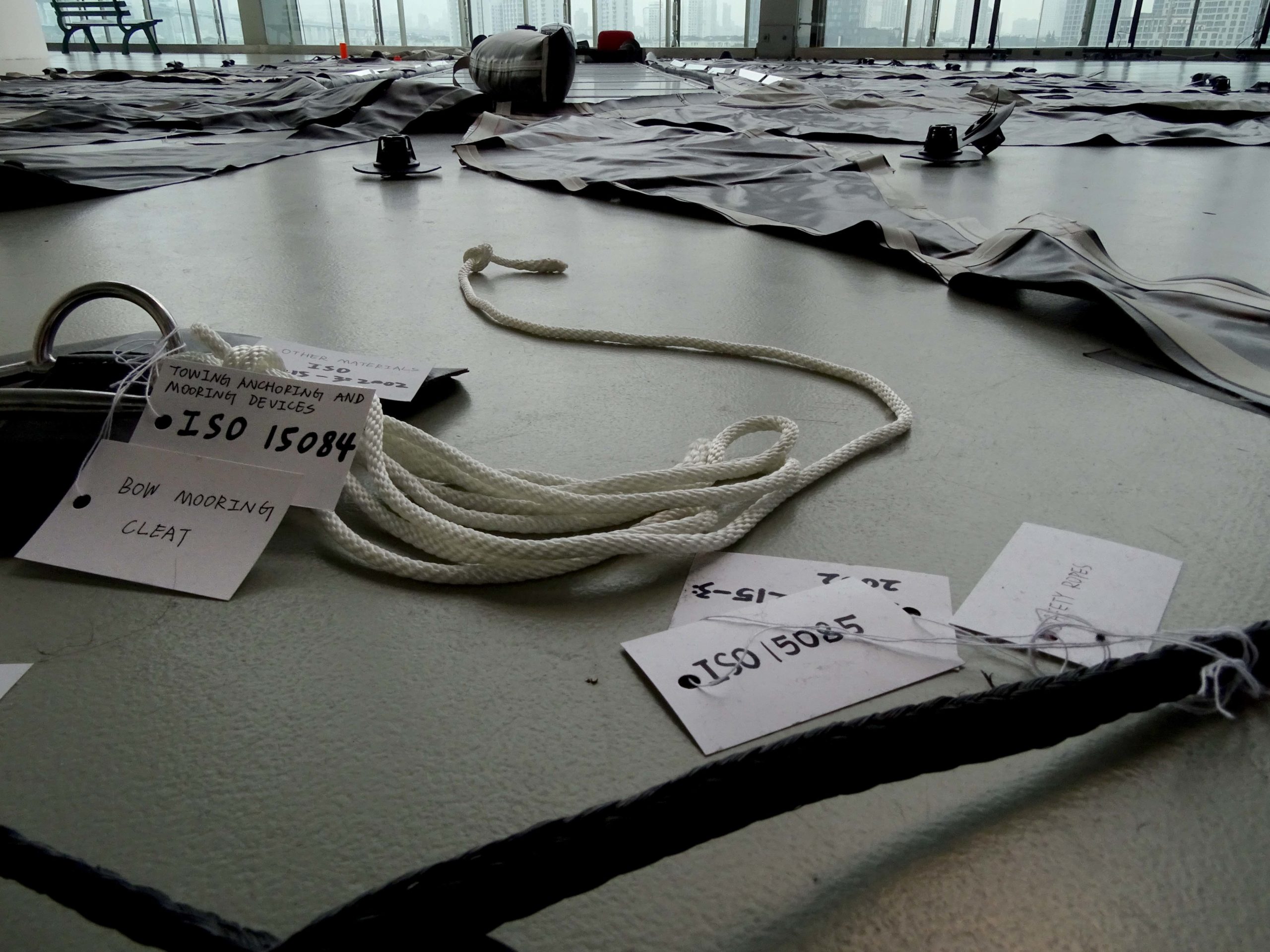
YoHA’s project examines how the boat goes from factory production in China to the North African coast and why it goes through the EU on the way to its point of purchase. What levels of governance must it blithely sail through without friction or pause to reach Africa before boomeranging back? The boat, YoHa claims, eventually sails on the placeless placeness of the sea–or on the untethered oceanic freed of nomos and in the gaps of certain kinds of sovereign control. It sails here to fuel imaginaries of flight from the economic and governmental margins. In the Mediterranean, site of sacrifices to the gods in antiquity, the migrants often are sacrificed to our wealth and privilege, to our presumed desirability that draws these souls to our empowered centres. There is a stark display of necropolitics as necrosovereignty, to rephrase Achille Mbembe. And YoHA wants to unpick the phenomenological, imaginary, political and aesthetic performances of this necropolitics through the materiality of the parts of an inflatable raft. (They ran workshops of raft assembly in Shanghai and Berlin.) The artistic project becomes a vehicle to examine those technics of the state and commerce that intend to reduce friction in the flow of goods but not necessarily in the flow of people traveling on those goods–technics that constitute humans in constructed and strategic gaps of sovereignty on the sea. What often get elided are the generative and productive dimensions of these technics and the nearly algorithmic nature of ISO regulations that constitute the human as always a mediated and technical object: a sacrifice to “the blue economy” and its globally divided bounty.[8] In this piece, the sublime blankness offered by some oceanic imaginaries, political and aesthetic, becomes clearly demarcated and delineated space shot through with friction on multiple scales of unevenness, rupture and partition. The indifference of the ocean is but a symptom of specific geopolitical lacunae and repression, a wound in the waters not easily bandaged up by the unbundled sovereignty of contradictory treaties and their inconsistent application.

Deepwater: Susan Schuppli’s “Nature Represents Itself”
Susan Schuppli’s “Nature Represents Itself” presents the British Petroleum Deepwater Horizon oil spill in its legal and aesthetic form to propose the ecological site as a material witness fully capable of representing its own damaged condition.[9] This auto-representation of environmental disaster posits a new medium unique to the components of the disaster; in many ways, it is a visual analogue to Reza Negarestani’s philosophical fiction, Cyclonopedia, which fabulated the non-human revenging force of petroleum. Using computer simulations to make visible the operation of hydrocarbon combinations as the molecules dispersed in seawater, Schuppli created a computer-generated video of the gulf’s surface as well as deep subsurface plumes. Her work incorporates the multiple visual channels of the event just listed. And when the oilrig collapsed into the murky depths of the water, its image-making capacities and modes of image-capture platforms began to multiply across various technical media and distribution platforms in an act of dispersion and proliferation at the visual/technical levels that mimicked the disastrous distribution of petroleum into the Gulf of Mexico. Schuppli notes that “our public gaze was suspended between two media geographies”: the murky underwater imagery of the gushing oil resisting all attempts to stop it and the Earth observation satellite imagery from datasets charting the spill’s swelling across the surface of the water: an auto-generated disaster film. The latter images were widely distributed through television platforms due to their spectacular qualities while the underwater video stream, as monotonous as it was propulsive, was relegated to less-visited online platforms.
But what else might we be watching in Schuppli’s piece, especially when the moving images work in dialogue with its soundtrack, which is constituted of readings from court documents of the legal cases taken on behalf of the ocean and its rights? The frictionless sovereignty of BP in its deep sea extractive practices versus any claims of sovereignty from the immediate aquatic environment penetrated by the extraction, as well as other areas affected by the spill? Human versus non-human sovereign claims? The court case brought by “the rights of nature” under the principle of universal jurisdiction in the courts in Quito, Ecuador 26 November 2016, in defense of the rights of the sea and understood as an integral part of nature, as the bestower of life and to which we have legal responsibility. The Ecuadorian constitution of 2008 recognizes nature as a subject of rights based on the principle of universal jurisdiction in relation to the biopolitics of life fundamental to sovereignty theory and humanity’s integral relation to each part of nature for its continued existence. The lawsuit filed against BP, as an international corporation endowed with specific subject rights and obligations in international law, argues that the sea, in its vastness and mysterious depths, holds “the secrets of existence” and is “the birthplace of life as we know it.”[10] The direct plaintiff is nature, the sea, and the indirect plaintiff is the future of humankind that is being robbed by rapacious exploitation of non-renewable resources, fossil fuels, and the destruction of those elements of nature necessary to sustain human existence. The horizon of nature and the horizon of humanity conjoin in the suit because they are not recognized by international systems of rights founded on “the colonial model of legal positivism” that recognizes international corporations as sovereign subjects endowed with rights and the future of humanity and nature hold no such recognition. The horizons of various sovereign subjects are at stake in the legal suit and its clash with international law, the friction of the Ecuadorean constitution with its rights for nature and the frictionless international agreements favouring extraction and exploitation.
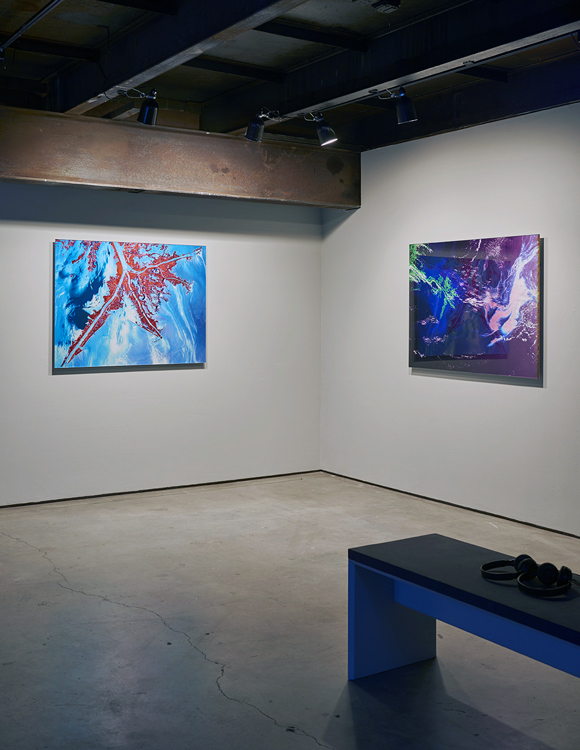
The Gulf of Mexico was made an unintentional canvas of human intervention and failure, as seen in the many images of the disaster taken by NASA’s pertinently named Terra satellite. Before being finally capped on 15 July 2010, approximately 4.1 billion barrels of crude oil had been emptied into the Gulf. As the oilrig burned and spewed plumes of dense smoke into the air, the real-time visual stream was primarily of the surfaces, with rudimentary underwater images provided through murky online sources. The visual register on screen in Schuppli’s work is that of the accident, which is a recurring feature of that axis where visual culture and technological infrastructure and political decision-making meet. As Paul Virilio consistently reminds us, the invention of any technology is also the invention of its failure, of its accidents.[11] The technology in its operation and its failure provide equally fodder for imagination planning, speculation and aesthetic production. This also applies to the speculative side: not merely inventing technologies, but inventing their accidents around which technological systems can be laid out in large-scale systems. Virilio in fact posited that the history of technology could better be queried and understood through a Museum of Disasters than our usual technophilic celebratory institutions. If such a site were to be built, Schuppli’s work could take a proud place there as one example of the long term legacy of petroculture as itself a planetary-scaled invention and engine of an accident, of a “slow violence” (cp. Rob Nixon), around which modern culture takes place, from transport to industry, from lifestyle to the variety of materials that sustain our sense of the everyday.
The visualizing technologies that Schuppli appropriates and reconstructs in “Nature Represents Itself” belongs to the battery of tools, including satellites, used to render the globe as simultaneously three-dimensional and two-dimensional object of visual control: 3-dimensional globe (a bounded sphere visible at all times) and a 2-dimensional flattened world without horizon (due to the complete surveillance of the entire planet all at the same time) thus making the earth’s surface a continual flat plane. The mastery afforded by our visual capacity to so manipulate the entire earth further fuels the ease of crossing time and space inherent in frictionless sovereignty. The desire to so control the planet properly took off early in the 20th century and reached its apotheosis in the exoskeletal ring of satellites tracking all movements on the planet. The accelerated use of aerial photography to replace non-machine generated cartography emerged simultaneously with increased air flight technology, cinematic camera technology and World War I, as Virilio has often examined. These “vision machines” are the precursors of those Schuppli deploys in her piece, but the World War I machines were used for aerial surveillance of the battlefield, generating millions of images for “the purpose of the systematic exploration of traces of the enemy in the landscape for the sole purpose of destroying the same” (Virilio 2010: 66). The blending of eye, motor and weapon propels every form it captures toward its ruin. The “instrumental collage” formed over minute-by-minute aerial documentation of the battlefield–its movements, logistics, structures and personnel–created a new synergetic process of purely instrumental application of the long distance, ubiquitous military gaze: an unblinking and intensifying vision of potential annihilation that leads to NASA satellite streaming the Deepwater Horizon ecological disaster in real-time. In both cases from the last century, the image generation and image capture constitute proleptic gestures of what will no longer exist.
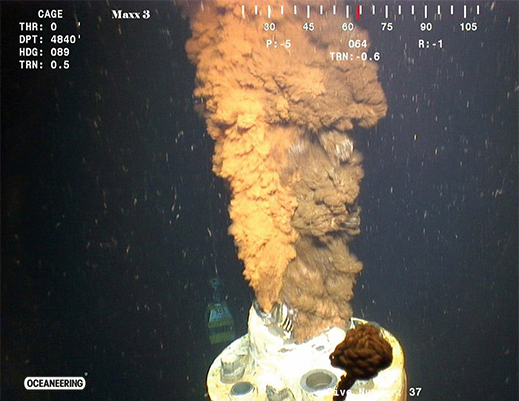
Read alongside each other, the internal “story-lines” of Yoh-HA and Schuppli’s works elaborate the entanglement between the governance of mobility within critical gaps in maritime laws of sovereignty, the emergent truth-claims, through those gaps, of an oceanic “subjectivity” that is neither zoomorphic nor anthropological in its juridical assertion of the right to life, and the artistic invocation, via de-individuated logics of departure, disposal and return, of a second-class population, governed in its (racialized) difference, according to strategically displaced costs of mortal risk. In After Fukushima: An Equivalence of Catastrophes, Jean-Luc Nancy describes the mise-en-scène of contemporary governmentality in a comparable light–crucially, within the symbolic parameters of volatile sea-levels–as the disastrous event that is at once military, geopolitical, technological, environmental and racist.[12] By citing the frictionless “equivalency” of each of each of these facets of sovereign rule, Nancy also suggests an affective economy that underpins its disposition. Insofar as each happening is economized and substituted for the experience of another, frictionless sovereignty tends toward a technically extensible, temporally illimitable, and internally organized extinction of difference–the “eco-technical”, then, as a horizonal tendency toward homogenization where each disaster is rendered in the affective equivalence of another, thereby eliding massive geopolitical asymmetries in relative wealth and risk-sharing in the strategic administration of life.
In this regard, Yo-HA and Schuppli’s works might be viewed diagnostically, as interventions into the idea of a horizonal future that still persists–immunologically, as it were–within “zones of affluence” under the homogenizing sign of “civilization” (Davis and Turpin). Both works deploy the trope of deep water to rescale an economy of affective disinvestment in the epoch of anthropogenic capital. As financial austerity, precarity, and the repeated containment of sequential crises occur, in the other vector of extractive capitalism, as the cascading effects/affects of the neoliberal management of citizenries, the possibility of the ungovernable accident is driven more deeply into the cultural imaginary. By suspending a singular conception of a horizonal future from the scenario of the accident, both works obliquely address the structure of such a de-historicised, properly catastrophic imaginary–one that begins to conceive of a return, via the fantasized loss of technological advantage, to the unmarked ground of terra nullius.
The primitivity of the desert-island, together with its privileged synecdoche, the figure of the shipwrecked survivor, has stood as an orienting fiction of the Western literary imagination. It recurs today against the crisis of term of “climate-change,” as the the fantasy of unprecedented forms-of-life that might flourish anew on earthly waste and large-scale engineering projects. In what follows, we suggest that this late romance of the autological, self-inspirited subject of techno-liberalism finds its articulation less in fin-de-siècle accounts of (“Western”) civilizational collapse and the anthropogenic event of species-extinction, than in the inflection of this same narrative by twentieth-century mythologies of postcolonial emergence, transformation and resilience–processes that materially reconstitute sovereign territory, as Goethe’s Faust, in an early account of Kulturtechnik, reclaimed land from the sea.[13]
Landed-Sea: Charles Lim’s “SEA STATE”
The vitalism of the island-state of Singapore is inseparable from the legacy of its post-Independent identification, which continues to position Singapore, at some distance from its regional neighbors, as a populous, open, multi-racial garden-city. Colloquially celebrated as “The Singapore Story”, this popular national narrative stresses the city-state’s painstaking accomplishment of a history of civic peace (especially in light of foundational ethno-religious or revolutionary violence in the constitution of neighbouring nation-states) and the associated rewards of financial stability. The equitable distribution of social protections and access to public infrastructure (particularly Singapore’s impressive public housing and transport systems) signifies not only an essential moment in the making of an affluent middle-class society out of a history of uneven colonial development, but also the historic legitimacy that has traditionally been accorded to the nation’s regime of single-party rule. The efficacy of these related claims to national sovereignty certainly derive from totemistic evocations of a national founding in the moment of decolonization (in the figure of Lee Kuan Yew and his increasingly contested legacies) and a successful politics of multiculturalism (in the peaceable governing of a multi-sectarian identity through the official pluralism of four “races”). Yet the real force of this dominant national imaginary is subtended more fundamentally, and, indeed, compellingly, by Singapore’s claim to economic exceptionalism in the region inter alia its leadership of International Maritime Capitals; its positioning as a global innovator in ‘green’ or sustainable urban planning; and its dominance of corporate debt markets in the ASEAN region through its governance of multinational infrastructural investments.
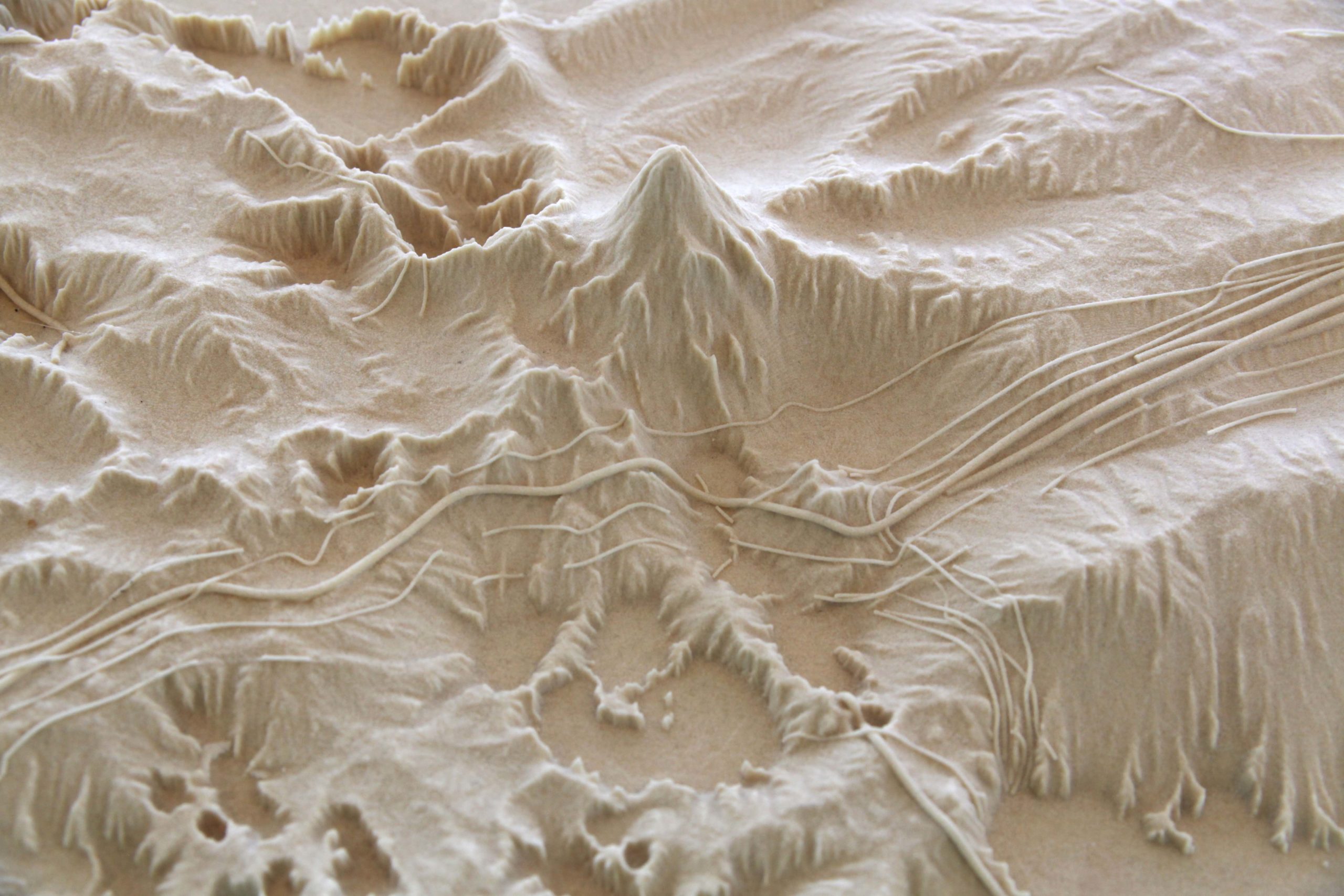
From SEA STATE 3: detail of 3-D inverted print of Singapore’s sand-bed, based on archival composites, hydrographical surveys, and personal anecdotes. (2015). Courtesy of the artist.
Elaborated over nearly fifteen years, Charles Lim’s multimodal project SEA STATE (2005 – ) is an expansive, unfolding, episodic chronicle of the Singapore Straits and Straits of Johor–the channels that separate the landmass of Singapore from Malaysia and Indonesia, respectively. Organized into “ten chapters”, the work is comprised of videos, photographs, found objects, audio-archives, nautical maps, and three-dimensional digital prints. Undertaken first with the curatorial collaboration of Mustafa Shabbir of the National Gallery at the inception of both the museum and the project in 2005, and through significant field and laboratory-based research, the work chronicles the littoral waters around Singapore through the allusive motif of the “sea-state”–the measure of volatility in a large body of water, which progresses upwards through a ten-point scale, to account for the force, height and intervals of waves. The scalar motif conjoins the multifaceted dimensions of this nearly authorless imagination of the island-nation to the work’s overarching conceptual ambition, in the effort to de-sublimate residual visual attachments to sea. Through gripping reversals between the thoroughly legislated spaces of Singapore’s littoral waters and the dynamic extension of the city’s land-mass over its shoreline, SEA STATE re-orders the distribution of visibility accorded historically by the island-state to the elements of land and sea–thus fully de-symbolizing the force of national history (and the idealizing periodicities associated with the “growth story” of a sovereign territory), while suggesting Singapore’s properly contemporary significance for the bio-physical politics of a late-liberal, “globalist” conjuncture. We introduce the work through this three-dimensional print of a detail of Singapore’s sea-bed (2017), which serves emblematically within its parameters to indicate SEA STATE’s prolific uses of the grid, the survey and the nautical chart. Together with an imputed genealogy of colonial navigation, these devices are used to introduce verticality into the field of visibility. Staged, here, among other things, is a reversible line of sight–an archaeological redirection of technologies of visualization and governance, or the technics of state sovereignty, toward evidence of their own deep presence in the sedimented matter of the print.
In material as well as ideational inversions between land and sea, this “inside-out” image confuses morphological distinctions, lending volume, instead, to the boundary-line between the elements. Conjoining the layered time of ancient, epochal formations on the sea-bed to the infrastructure of digital capitalism, the piece strips the sea of conventional semiotic descriptors, exposing, instead, a topography of de-nationalised, hyper-connected surfaces. The modulations of this terrain are shaped and underscored as much by the element of water and the deep-time of geology as through de-materialized flows of information–as striking as the bared and degradable surface of the sea-bed is the uncanny visibility, accorded from a precise height, to the lines of fibre-optic communication cables impressed into the sand. These submarine cables are immediately suggestive of fossilised traces, signs, perhaps, of the symbolic and affective infrastructure that lends coherence to the proposition of Singapore as a sovereign “sea-state”. But they are, in every instance, apparent to the viewer in and as their delicate materiality. Surfacing from a location of profound invisibility–as technology–these infrastructural connectivities are exposed to the viewer of SEA STATE less as the representational markers of national identity than as sheer material evidence of the deep historical presence of authority in the matter and contours of biological life in Singapore.
Positioned on the southern tip of the Malaysian peninsula, Singapore’s history of rapid planned urban development suggests how the geophysical boundaries between island and sea have been historically experienced–notwithstanding the twentieth-century narrative of dirigiste postcolonial development, the various iterations, installations and media of SEA STATE capture the boundary-line between land and sea as a state of constant motion. Built up in the 1950s in the decade before Independence on drained and reclaimed swampland, 87% of the shoreline today is constructed of concrete. Lacking crude-deposits of its own, Singapore tranships half of the world’s annual supply of crude oil, and a fifth of the world’s containers. Emerging into global visibility as the world’s second busiest port, Singapore’s identity remains tied, nevertheless, to its landmass, as land-reclamation projects accelerate to accommodate rapid urban development on the island. In historical memory, Singapore recalls its origins as a colonial sea-port, and its reliance, almost exclusively, on the ocean for the traffic in international goods, labour, and credit; the scale of transformation in this maritime legacy might be indexed through Singapore’s massive investments in industrial bases on the land; these serve as both processing stations and transit points, not so much for the finished commodities of globalization, as for the crude oil and by-products that go into and out of the commodity-chain. While Singapore’s story of post-Independent autonomy is typically narrated through the dearth of indigenous resources-based industries on the island, that narrative of postcolonial resilience is repurposed today, as an account of how Singapore flourished through the 2007/8 banking crisis to consolidate itself, globally, as the Asian future of advanced industrial economies.[14]
Singapore’s self-positioning as a vanguard within the capitalist-horizonal coordinates of advanced societies attach it, on the one side, to robust twentieth-century mythologies of postcolonial emergence, and on the other, to its visible ascendancy within global finance, as a regional guarantor of multinational debt. In oblique allusions to state-protected enterprises involving oil refining, landfill engineering, waste processing, and requisite flows of wage-labor–the analogical underside, as it were, to Singapore’s networked life and claim to culture–SEA STATE exemplifies the infrastructural axiomatics of protean, flexible, or accommodatory forms of resilience acquired by contemporary finance capital.[15]
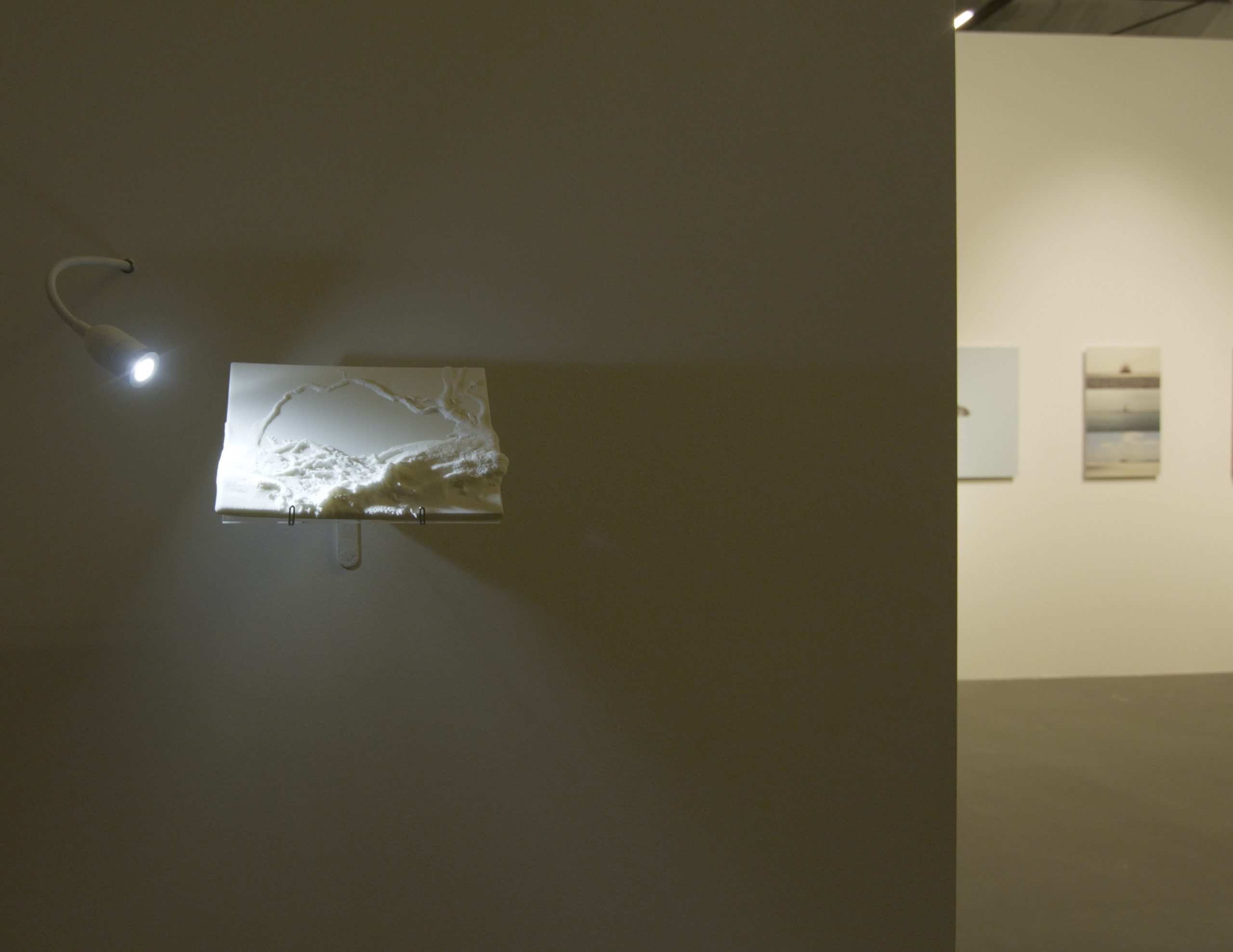
Between 2002 and 2008, the islet of Pulau Sajahat disappeared off the northeast coast of Singapore. The visible shoreline of the island, indeed, its full one-hectare land-mass, was consumed not by rising sea-levels; it was subsumed, by proclamation of the Maritime and Port Authority, to reclamation projects intended toward the strategic extension of Singapore’s territorial coastline. As Pauline Yao notes in her own, evocative commentary on Lim’s art of oceanic sovereignty, the Maritime and Port Authority staged a symbolic rehearsal of such geophysical disappearance by erasing the island, a second time, from nautical charts of Singapore’s territory. Lim’s exercise in the measuring of such disappearance is, therefore, studied in every sense, returning duration to processes of de-materialization. SEA STATE 2, sequenced through the title “As Evil Disappears and Safe Seas Appear”, is directed by an unsettling materialism that insists past Pulau Sajahat’s vanishing–and even further, beyond the geologically-grounded proposition of a deep-past of rock and ancient sediment–on the continued existence of the entity’s depth and surface area. First exhibited in 2012 at Future Perfect in Singapore, prints, videos, 3-D-printed objects, and maps index, across this vanishing point in Singapore’s geography, the factuality of an island that persists in inverted, even inexorcisable form as a properly unrepresentable, if entirely measurable presence; surrounded, now, by land instead of water.
Deriving its name from jahat, the Malay word for dark magic, or just elemental trickery, the missing island is recalled obliquely in its historic notoriety as a harbor for pirates (and therefore, perhaps, as an ironic allusion to pre-modern, de-centred modalities of social violence)–in a stunning lexical reversal, Lim stages the “techno-shamanistic” exorcism of darkness itself from Singapore’s urban imaginary. [16] By sequencing the island through the indices of a disembodied factuality–rather than through material traces of the entity itself–Lim secularizes, above all, the ritualized erasures involved on the part of the Singapore government in its bid to secure the nation’s economic hegemony in the region.[17] In mapping divisions of wealth and labour onto littoral boundaries–in Evil Island, the process is linked to technics of territorial mapping and negotiation–SEA STATE 2 continues to allude to the works’ photographic constellation of dredging ships–rather than pirate vessels–to document the social life of sand. From this distance, sand acquires visibility not as an elemental aspect of the archipelago’s shared geological or even ideological past, but as a basic component in the industrialised uses of concrete–sand, in other words, is at the foundations of Singapore’s built environment. In their unremarkable industrial forms and the de-populated patterns of their traffic, the photographed vessels suggest, innocuously, that exchanges in sand outstrip even the transfers of working populations between islands in the archipelago. (Thus, coastal terrains in the region might lose people not only because of migration out to the service-economy of Singapore, but because coastal communities literally lose the land.) These photographic micro-essays suggest that the city-state consumes sand to create the very land that now “drowns” the missing island; their own slow, machinic appearance suggests how these processes negate the historicity of built-space itself by suppressing visible relations between work and the use-values of the environment.[18]

In the video works of SEA STATE 6, which debuted at the Venice Biennale in 2015, Lim presents an exposition of the underground construction of the first phase of the 427-foot-deep Jurong Rock Caverns on Jurong Island (itself a reclamation project that artificially conjoins seven separate land-masses into a continuous underground formation). The still image above is from a 6-minute video-loop in which Indonesian and South-Asian workers lay the foundations for the cave. There is theatricality in the action, framed by mining-lamps, as well as a painterly elongation of light as the men carry Lim’s sailboat–rather than a cable–deep into the Leviathan-like interiority of the ocean, punctuating their run with echoing shouts of effort. As Lim exhibited this most recent elaboration of SEA STATE in Venice, the caves stood as the first underground rock-formation deployed exclusively for oil storage in Southeast Asia. The need for containing massive volumes of oil produces, paradoxically, a further self-regulating infrastructural economy that is, in turn, tied back to the financing and construction of land-reclamation. The scale of these exchanges, imputed in Lim’s work, to the sublime enormity of the Jurong Caves, suggests massive infrastructural swaps between unevenly positioned sovereign states–transfers of wealth, as it were, between the coast-line impoverished, territorially diminutive island of Singapore and the sand-rich borders of Cambodia or Indonesia. Scored by the bodily movements and exhalations of imported labour, the Jurong Caves rise against their fantastical, even mystical appearance, as a corroboration of the deep force of sovereign authority as it arcs through and over the fundaments of bio-physical existence. The loop elaborates the distinction between (racialized, internally divided) life and its environment as catastrophically degradable–or otherwise, as a boundary-line so immersively monetized as to transfigure, with Faustian ingenuity, any residual experiential insistence on their difference.
The specular exchange we suggest, above, between the citations from Lim’s SEA STATE 6 and the details from As Evil Disappears proposes the quality and infrastructure of a total landedness that, in effect, defines the sea under conditions of extractive capitalism. Even further, by de-subjectivizing any position (‘perspective’) on such a conjuncture, devices of visualization, measurement and the infrastructure of digital capitalism are re-directed anthropogenically toward a reflection on their own historicity–an unfolding attestation to their own imprint in the frictionless extension of sovereignty over the sea, and, in this way, a gesture toward the massive imbalances of scale implied in the relative values of the island-state’s aggressively compounded territorial coastline, and the geography of its regional neighbors. To the degree that such astounding geophysical asymmetries also imply the enmeshment of the island in economic and existential precarity, it is, in SEA STATE’s account, a relation of interdependency that remains phenomenologically invisible to the landed view-point. Capturing the Straits of Johor through unnerving impressions of bio-physical vulnerability, the staggered chapters of SEA STATE disclose the claims of the oceanic, constructing, in the process, an alternative genealogy to the hegemonic visibilities of national sovereignty.
In a tour de force account of contemporary artistic developments in Singapore over the last decade, Michael Fischer places Lim, at the outset of his detailed ethnography, as intimating an “ecological biophysical future, and thus, also a critical-anthropological” vision not reducible to the symbolics of postcolonial identity (Fischer, 4-5). We might extend that study, with and against the periodicities of conventional art-history, to propose that the spaces between Evil Island and the video-installations of SEA STATE 6 wrest the question of a global futurity–together with the catastrophic imagination of the accident–from the horizonal periodicities of the nation to lead chronology, together with its limit-term, the advent of the Anthropocene, into the sea. Captured with flattened affect as the “life-line” for land-based dwelling, the trope of the sea-level entangles the claim to frictionless development in scenes of unprecedented eco-technical destruction, even while returning specificity to the prospect of the industrial accident. In explosive auditory evidence of the shouts of laboring men, and across a compressed visual history of the construction of the perpetually ‘disappearing’ difference between land and sea, SEA STATE eschews the romance of Singapore’s maritime import as a post/colonial port city for a dispassionate materialism that places the island’s elemental presence in the world alongside technics of visualization, extraction and information. The sea, as assembled by Lim, is neither infinite potentiality nor the theater of tragic negation (say, for example, in the origin-myth of the South-East Asian nation in a precolonial sea-faring life-world erased from historical memory, first, by the agents of imperial dominance, and then again, perhaps, by the depredations of state-led modernization).[19] Instead, the sea emerges into renewed visibility only after its subjection to totalizing processes of socialization–as a rationalized body of knowledge, in other words, capable of advancing corroborative or evidential truth-claims about our contemporary conjuncture while inviting us to imagine a departure, altogether, from the postulates of frictionless sovereignty.
Chiasmus: Oceanic/Aesthetic Subjectivity
We discuss the artworks of YoHA, Susan Schuppli and Charles Lim as indices of the various gaps and fissures in the otherwise seamless visualization of the world of frictionless sovereignty, so often imagined in its most simplistic and default economic guise. The topoi of unevenness operative in the current structure of capitalism function despite and through the oceanic imaginary; a space impervious to lines of legislated division emerges, shot through with deep-water striations of power and contention, resistance and claim, Life and its ultimate event-horizon, extinction. In the exchanges between these three pieces, an alternative notion of regional contiguities through the sea emerges–not through the demarcation of conventional territories or the refolding of the work’s contention back to the representation of an originary “water-borne” identity, but through a dynamic, on-going nexus of circulation whose materials and movement are subject to different modalities of governmentality; and are constitutive of the particular “distributed” subjectivities evoked in each piece. Neither fully frictional nor frictionless but incessantly fictionalized, the distributed subjectivities of the sea surface their discrete, self-corroborating “stories” even as these tend, in the epoch of anthropogenic capital, toward an overarching account of the water’s universal disposition. Eloquently invoked in these three pieces, the technics through which prevailing regimes of bio-ontological difference are regulated, are, themselves, offered as an aesthetic value–the reflective means for thinking the ineluctable contradictions and willed lacunae of the frictionless. The same phantasmagorical formulations that subtend the oceanic imaginary to underscore and mould geopolitical, economic and eco-technical operations materially and immaterially, reconstitute the aesthetic subject immanently, as a critical agent.
Ryan Bishop is Professor of Global Art and Politics at the Winchester School of Art, University of Southampton. His most recent book is Technocrats of the Imagination: Art, Technology and the Military-Industrial Avant-garde (co-authored with John Beck, 2020), and he is co-editor of Cultural Politics (Duke UP) and its book series “A Cultural Politics Book” (Duke UP).
Tania Roy is Senior Lecturer and Chair of the Graduate Programme in English Literature at the National University of Singapore. She is the author of The Architects of Late Style in India: Aesthetic Form after the Twentieth-century Novel (Routledge, 2019), an examination of T.W. Adorno’ s aesthetics of lateness, with reference to mid- late twentieth century Indian modernism, and its contemporary artistic legacies. Her related interests, including numerous publications on contemporary visual art in post-liberalized India, with an emphasis on the memory work in its relation to civic violence, have appeared or are forthcoming in Political Culture, Theory Culture and Society, European Paradigms and Journal of Postcolonial Studies, and in several book chapters. She offers seminars in Critical Theory, especially the aesthetic of the Frankfurt School, postcolonial studies and world literature; and graduate topics on trauma studies and literature.
References
Bishop, Ryan (2018) “Felo de se: The Munus of Remote Sensing” boundary 2 45:4, pp. 41-63.
Connery, Christopher (1996) “The Oceanic Feeling and the Regional Imaginary”, in Rob Wilson and Wimal Dissanayake (eds) Global/Local: Cultural Production and the Transnational Imaginary. Durham: Duke University Press, pp. 284-311.
— (2001) “Ideologies of Land and Sea Alfred Thayer Mahan, Carl Schmitt, and the Shaping of Global Myth Elements” boundary 2. 28:2, 173-201.
Davis, Heather and Etienne Turpin (2015) Art in the Anthropocene: Encounters among Aesthetics, Politics and Epistemologies. Open Humanities Press.
Fischer, Michael M. J. (2019) “Challenging Art as Cultural Systems for Cliff from the 21st Century: Light Shows, Shadow Plays, Pressure Points,” Geertz Memorial Lecture, Princeton University (ms.)
Foucault, Michel (1990) The History of Sexuality, Vol. 1: An Introduction, trans. Robert Hurley, Reissue edition. New York: Vintage.
— (2007) Security, Territory, Population: Lectures at the College de France 1977-1978, trans. Graham Burchell. Basingstoke UK and NY: Palgrave Macmillan.
Goethe, Johann Wolfgang (1962) Faust, trans. Walter Kaufmann. New York: Anchor Books.
Lau, Yanyi (2016) “Exclusive Interview with Charles Lim”, Artling, https://theartling.com/en/artzine/exclusive-interview-artist-charles-lim/ (website last accessed on 21/2/20).
Nancy, Jean-Luc (2014) After Fukushima: The Equivalence of Catastrophes. trans. Charlotte Mandell. New York: Fordham University Press.
Parikka, Jussi (2015) A Geology of Media. Minneapolis and London: University of Minnesota Press.
Povinelli, Elizabeth (2005) “‘What’s Love Got to Do With It?’ The Race of Freedom and the Drag of Descent.” Social Analysis: The International Journal of Anthropology. 49: 2, pp. 173-181.
— (2016) Geontologies: A Requiem to Late Liberalism. Durham: Duke University Press.
Schmitt, Carl (2006) The Nomos of the Earth, trans. by G.L. Ulmen. New York: Telos Press.
Schuppli, Susan (2020) Material Witness: Media, Forensics, Evidence. Cambridge MA and London: MIT Press.
Virilio, Paul (2009) Aesthetics of Disappearance, trans. Philip Beitchman. New York: Semiotext(e).
— (2010) The University of Disaster, trans. Julie Rose. Cambridge: Polity Press.
Vismann, Cornelia (2010) “Starting from Scratch: Concepts of Order in No Man’s Land,” in Bernd-Rudiger Hüppauf (ed) War, Violence and the Modern Condition. Berlin: De Gruyter.
Yao, Pauline J. (2015) “Close-up: Floating World”. Artforum 53:8.
[1] The term is introduced in the now widely disseminated lectures, Security, Territory, Population, given at the Collège de France between 1977 and 1978. In the following year, in a series of lectures published, somewhat misleadingly, as The Birth of Biopolitics, appears to digress from the idea of biopower to examine German and Austrian post-War liberalism, together with the Chicago school, to advance and historically specify his account of governmentality within the paradigm of neoliberalism.
[2]While analysing the emergence of neoliberalism as a set of economic policies, Foucault framed neoliberalism (presciently, before the emergence of Thatcher and Reagan) not only in terms of a set of economic policies based on governance through monetarism, de-regulation, privatization and the securitization of borders, but also as a productive, subjectivizing power that marked, in the late twentieth-century, the emergence of a new paradigm in the governance of human beings. Where liberal modalities of governing optimize individual freedom, neoliberalism represented a mode of rationality that transformed the capacities of free-acting agents into the very technology through which individuals are governed, or otherwise, into a political strategy that produces the quality and capacities of agency, itself, into the tool of governable subjectivities.
[3] The concept of geontopower develops Povinelli’s earlier conceptualization of biopolitics, as it operated through the paradigm of multicultural recognition. Biopolitics subtends the order of “settler liberalism”, in other words, or an organization of society that distinguishes between future-oriented, self-inspiriting identities, the autological subject, and those identified with genealogical origin–“indigenous” subjectivities, for example, that are imagined as delimited, through descent, by their communal obligations to the past (“What’s Love Got to Do with It?”). The provocation inherent to the term “settler liberalism” suggests that the “autonomous” subject of liberal rights is comprehensible, currently, less as a citizen than as a “stakeholder” in the organizational logic of markets – a logic that at once affirms and de-legitimises difference for the purposes of extraction and accumulation through the assertion of ontological l differences between Life and Non-life (2016, 35).
[4] See Christopher L. Connery, “The Oceanic Feeling and the Regional Imaginary” for a discussion of the oceanic sublime.
[5] See Bishop (2018).
[6] See http://yoha.co.uk/node/1076 and https://transmediale.de/content/plastic-raft-of-lampedusa
[7] See http://watchthemed.net/index.php/page/index/1
[8] A related project by Thomas Keenan and Sohrab Mohebbi, with Charles Heller and Lorenzo Pezzani, called “It is Obvious from the Map” charts the flows of migrant boats and how state actors use sea-based sensors to track them without having to offer humanitarian aid. Forensic Oceanography and Watch the Med offer explanations of rights at sea and attempt to use the same teletechnological sensory devices for exclusion to be converted into NGO oversight of national actions.
[9] See Schuppli (2020) for a fuller reading of the theoretical, ecological, legal and aesthetic frames within which her piece is placed.
[10] https://www.rainforest-rescue.org/news/3237/plaintiff-to-bp-for-nature-s-rights-in-ecuador-s-constitutional-court
[11] See, for example, Virilio’s Aesthetics of Disappearance and The University of Disaster.
[12] For Nancy, the prospect of the oceanic disaster actualizes the catastrophic logic indexed by Marx’s law of “general equivalence”: “This absorption [of values to the logic of substitution] implies a close connection between capitalism and technological development as we know it. More precisely, it is the connection of an equivalence and a limitless interchangeability of forces, products, agents or actors, meanings or values—since the value of any value is its equivalence. Catastrophes are not all of the same gravity, but they all connect with the totality of interdependences that make up general equivalence”. (5-6)
[13] In the less frequently read Second Act of Goethe’s Faust, the protagonist has transformed into a land developer intent on overcoming the boundary between land and sea through the mobilization of a massive labor force working day and night to realize his plans–the modernist drive for liberation undertaken with a Mephistophelian zeal (indeed aided by Mephistopheles himself). Faust’s plan to provide the proletariat a new kind of economic possibility through this development wishes to “open space for many millions/To live, not securely, but free for action” (lines 11563-4). The theoretical term Kulturtechnik originally applied to agrarian technics but has since migrated to other forms of human endeavors, from large-scale land development projects to literary studies and media studies. The Faust at the end of Goethe’s play can be recognized in numerous large-scale engineering projects of the present, including those addressed in the artworks discussed in this article.
[14] In a 2017 work entitled “Silent Clap of the Status Quo,” Lim constructs a video-archive of “Inspection-videos” of submarine tele-communication networks, suggesting how this “deep” archival information already striates the “phrase, ‘high seas’–a zone that is thought to be free from control of any individual nation or state [following’ Article 112 of the United Nations Convention on the Law of the Sea.” The UNCLoS legislation permits any state to lay cables on the bed of deep-sea waters – to paraphrase Lim’s presentation notes, this frictionless, extensible opening to sovereign claims upon the matter and value of the sea-bed is underpinned by a cultural depiction of “the sea [as] endless[ly] as unoccupiable.”
[15] The distribution of such imagined in/visibilities has strategic import: while the US, Japan and Europe appear to dominate the satellite communication industry, only 1 per cent of data transmission is accounted for through such infrastructure. Huawei, in 2019, completed a cable network from South America to Africa even as America continues to lobby stridently to block China from 5th-generation wireless service infrastructure. We thank Mustafa Shabbir for alerting us to this detail, which stands, in the context of the essay, as another example of the exploitable–prolifically significant–fissures residing between legislative and cultural encodings of the sea-bed.
[16] Lim uses the word in an interview with Yunyi Lau, for Artling magazine in 2016, suggesting also the curatorial choices that have informed this processual work: in the context of curating the Singapore Pavilion and Lim’s SEA STATE 6 at the Venice Biennale Shabbir Hussain Mustafa borrows the phrase from the Thai curator Apinan Poshynanda to suggest, also, how, in economic guise, the claim to frictionless sovereignty produces fictions of infinite value from finite resources.
[17] Through the process of Lim’s documentation, the area of the sea that was subsumed to Singapore’s coastline remained under the legislation of the Maritime and Port Authority, to be subsequently erased from maritime maps once its entity was transferred to the Land Authority. The process of ‘transfer’ itself encodes the origins of Singapore as a post/colonial port-city into on-going loops of historical return, extension and transformation. In 1973, the Singapore state re-activated the colonial era law of Proclamation that originally enabled the (settler) state to possess land from its inhabitants, and which had been used historically for reclamation projects in the Straits. Proclamation–as both legal and rhetorical device–transfigures the phenomenological existence of both land sea to call up an account of the nation’s landed resilience in face of a resource poor environment–even while “radically desocial[izing]” the sea (Fischer, 8). The repurposed Foreshore Act enabled the post-Independent state to seize shorelines for the major land reclamations that today comprise the coastlines of the city (Fischer, 8).
[18] By the same token, the sea is exposed in its constant subjection to modalities of resocialization, which systematically remove coastal populations from what Lim terms, communal “bodies of knowledge”. Forms of domestic architecture of stilted long-houses on the water, related networks linking fishing routes to markets or the infrastructure of schools and roads, across to sailing techniques, design and crafting–these knowledge-forms exist in immanent, “practical interactions” with the sea, for Lim, especially in equatorial zones where the body is easily immersible in waters whose temperatures approximate “blood-heat” (conversation with the artist). Arguably, SEASTATE removes representation from these histories of habitability to document the resocialization of the sea since the proclamation of the Foreshore’s Act. The propulsive extension of Singapore’s sovereignty into surrounding water bodies is, in other words, a hegemonic mode of knowledge, advanced into both the ocean and its archipelagic contiguities with island-formations via the semiotic marks of legislation; visual technics of mapping; and the encoding of the modern state, in the grid and the survey, through the action of erasure.
[19] Instructive is the radical distance Lim’s work takes from modernist traditions of art-history associated with the “Nasuantara” paradigm, a regional model that emphasises oceanic histories of cultural traffic and therefore, attention to artistic traditions that imagine transnational ethnic solidarities (the 13th century Old Javanese word is mobilized in its multiple geographical denotations, as signifying both “Indonesia” and “the Malay World”, to inter-weave and relativize national art-histories).

